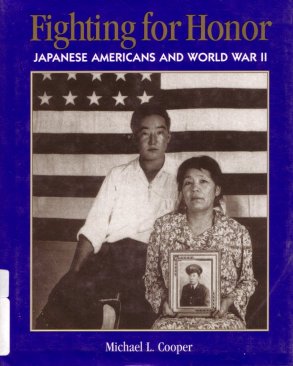
Fighting for Honor: Japanese Americans and World War II
Michael L. Cooper, 2000

The author starts by discussing the reaction to Pearl Harbor and the hysteria that resulted when a Japanese submarine shelled an oil refinery (with almost no success, however). Then he goes into a short history of the internment program.
The next chapter starts out discussing the Chinese immigration to the U.S. and then moves into a discussion of the Japanese immigration. The third chapter discusses the internment camps. It goes into what they did in the camps, the loyalty questionnaire and Army recruitment efforts in the camps. Some of the men who did volunteer ran into considerable harassment from others who did not support the idea of volunteering for a nation that had put them behind barbed wire.
Training Camp is the title of the next chapter and the author goes right into how the Hawaiian Nisei and the mainlanders did not get along at all well. The chapter has a good bit of information in it and an excellent selection of photographs.
The next chapter discusses the fighting in Italy and is extremely graphic in its description of the horrors of the war. This is not a pretty chapter but it's a very good examination of the kinds of things that really happen during a war.
Chapter 6 deals with the resettlement of the Japanese Americans in the camps. The author points out the hatred for the Japanese that still existed on the West Coast and some of the reasons.
Chapter 7 returns to the military Nisei units. The rescue of the "Lost Battalion" is covered in the chapter. The next chapter goes back to the fighting in Italy and tells how an American commander gave a Nisei unit a week to capture a particular mountain target and they did it within two days, then moved on to capture other targets and cut supply lines.
Again, some of the discussion in the chapter is extremely gruesome. The end of the war in the Pacific is covered rather quickly.
Chapter 9 covers the evacuees as they returned to their homes, finding that many if not all of the possessions they thought had been safely stored were now gone. The chapter goes into some of the hatred that they found but also covers some of the help they got from the white community.
Positive points of the book: A lot of excellent photographs and some good information.
Negative points: This is absolutely not a book for everyone, especially for younger readers, as the discussion of some of the fighting in the war and the types of wounds the men received are extremely graphic and could easily be upsetting to some. This is important in that this library book was classified as a Young Adult book. Also, the organization of the book is a little odd in that it sort of seems to bounce around a bit in what it's discussing.
Main Index
Japan main page
Japanese-American Internment Camps index page
Japan and World War II index page
|